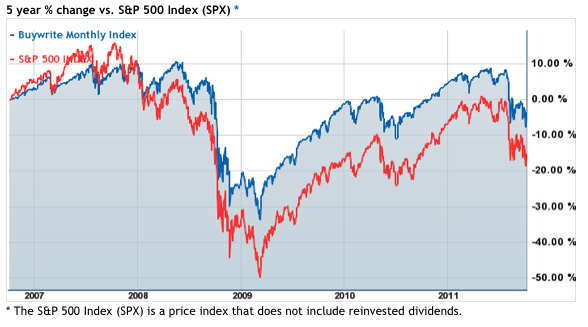Is Covered Call Writing Using Weekly Options A Good Idea?
The use of covered call / buy-write strategies within an investment portfolio has been found to yield slightly greater returns with only two-thirds the volatility, making it one of the more popular portfolio risk management strategies. The traditional buy-write strategy involves purchasing an underlying asset (equity, ETF, Index, etc…) and simultaneously selling a call option on the underlying, typically with an expiration of 4 or more weeks. The written call provides additional income to the position but in return limits upside appreciation in the underlying. Thus in bullish markets, monthly buy-write strategies tend to underperform vanilla long-only strategies. The buy-write strategy does, however, outperform long-only strategies in bearish to slightly bullish markets as the investor retains the collected call premium to use as a partial offset to losses in the underlying. To better illustrate the difference, the chart below highlights the performance of a buy-write portfolio (BXM) vs. a vanilla market portfolio (SPX) over the last 5 years.
 While the advantages and disadvantages of monthly covered call writing programs have been explored extensively over the last decade (see Callan Buy Write Index Study, Russell Buy-Write Study, Finding Alpha via Covered Index Writing), the introduction of weekly options in the mix provides investors with an opportunity to potentially yield greater results from a weekly covered call writing strategy vs. the traditional monthly covered call writing strategy, so let’s explore…
While the advantages and disadvantages of monthly covered call writing programs have been explored extensively over the last decade (see Callan Buy Write Index Study, Russell Buy-Write Study, Finding Alpha via Covered Index Writing), the introduction of weekly options in the mix provides investors with an opportunity to potentially yield greater results from a weekly covered call writing strategy vs. the traditional monthly covered call writing strategy, so let’s explore…
Weekly Covered Call Writing Advantages
The primary reason covered call strategies outperform non covered call strategies is due to the negative volatility risk premium inherent in options, which basically implies that the implied volatility in options is generally priced higher than the resultant realized volatility of the underlying, thus options tend to trade at a persistent premium to fair value. Not so long ago I backtested how closely the implied volatility of S&P call options predicted resultant realized volatility and found (to nobody’s surprise) that the implied volatility priced into at-the-money S&P call options exceeded the subsequent realized volatility around 80% of the time over a 10-year time frame. Clearly the reason smart traders prefer to be net sellers of options! With weekly options still being a relatively new trading vehicle I have yet to see any white papers exploring this “negative volatility risk premium” in weekly options but my intuition tells me that it is as prevalent in weekly options as it is in monthly options.
That being said, employing a weekly options covered call strategy allows investors to sell this generally overpriced implied volatility 4x a month instead of just once! In doing so investors are able to collect, on average, over double the amount of premium (dependent on absolute implied volatility levels).
Covered call programs utilizing weekly options also address the main source of monthly covered call strategy underperformance, exercise cost. As mentioned earlier, covered call strategies underperform in bullish markets as upside is capped to the written call strike level (+ collected premium). This presents a bit of an issue given the written call in a normal monthly covered call scenario has an expiration date of 30 days or so, giving the underlying ample time to move significantly away from the written strike. The use of weekly options within the covered call strategy provides flexibility in that the shorter time frame allows investors to effectively adjust the written strike level and seemingly reduce the major exercise cost drag.
Weekly Covered Call Writing Disadvantages
So generate double the income and potentially reduce exercise cost, weekly options sure look like a winner over the monthly variety, right? But in the immortal words of Lee Corso….not so fast my friend! Keep in mind selling call options 4x a month vs. once a month leads to many more transactions, and more importantly, many more transaction fees (commissions). Commission costs will generally eat away at a portion of the excess return in shifting from a monthly to a weekly covered call strategy but to what extent depends largely on the commission structure and rates being charged by your trading platform. And I’d also be remiss if I didn’t mention the potential tax implications of short-term profit generation which also could have an adverse effect on portfolio returns, so it would probably be wise to consult a tax accountant before implementation.
Similar Posts:
- Gold A Safe Haven No More? – GLD Options Trading Strategy
- Selling Weekly Put Options in Yahoo (YHOO)
- Selling Energy Sector Skew – XOP
Mr. Saunders serves as Mesa’s Vice President of Marketing, bringing with him a wealth of experience in strategic marketing and operations. In this role, Mr. Saunders is responsible for overseeing all marketing activities, utilizing a blend of traditional and digital strategies to enhance brand presence and profitability, managing a multi-million dollar marketing budget across various media platforms, and leading the continued implementation of CRM systems to streamline customer engagement and drive business growth.


